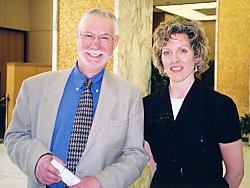 |
  
September / October
2001
Vol. 33, no. 5
|
SAVOIR FAIRE
The Past in Prime Time:
Canada: A People’s History
Risë Segall, Research and Information Services

Hubert Gendron and Monica MacDonald. |
A standing-room-only audience for the May seminar in the National Library’s SAVOIR FAIRE lecture series was treated to a fascinating behind-the-scenes view of the popular CBC/Radio Canada television series Canada: A People’s History. Hubert Gendron, Senior Producer for the series, and Monica MacDonald, the National Archives’ Research Coordinator, discussed the complex processes involved in producing the series and their use of the collections of both the National Library and National Archives of Canada.
Hubert Gendron began the seminar by sharing with the audience the fundamental principles that guided the development of the television series. The primary objective was to create a prime-time series that would be accessible to the widest possible audience. To ensure the success of the series, it was felt important to address the reality that there is not one Canadian history but many.
Depending upon where Canadians have attended school, they have experienced different curricula and points of view relating to history. To illustrate this point, Hubert Gendron shared a personal anecdote. Being educated in Quebec in the ’50s, the only Howe that Gendron was familiar with in his youth was not the historical figure Joseph Howe but the hockey player Gordie Howe.
Another fundamental decision that was made from the outset was to have exactly the same content for the English version, Canada: A People’s History, as for the French version, Le Canada: une histoire populaire.
To meet the challenge of creating popular interest in a series focussing on what Mr. Gendron described as three seemingly soporific words - documentary, history and Canada - a number of key decisions were made. A guiding creative principle for the series was to present history through the eyes of the people that lived it. There would be no historians on the screen. A journalistic style would be used, with stories being told using personal testimony, photographs and historical texts.
Hubert Gendron indicated that the most hotly debated and controversial decision of the production team was the use of actors who spoke directly to the camera and whose dialogue was based on historical texts and documents. In this decision, they were inspired by two emotionally powerful American historical documentaries: The Civil War, produced by Ken Burns for PBS, and Liberty! The American Revolution. With this key decision to use historical testimony and documents to bring history to life, the next challenge was to search out the compelling voices, the texts and the images to do the job.
In his account of the development of an early episode of the series, Hubert Gendron illustrated the challenge involved in finding the right voice to tell the story. The episode in question dealt with an important component of 17th century New France society: the Régiment de Carignan-Salières. Mr. Gendron had written the script but was unable to find a witness to the Regiment’s disastrous winter campaign against the Iroquois. By following a footnote in a history of the Regiment, he discovered the personal testimony that would bring this piece of history to life: the enraged voice of the Marquis de Salières, the good commander who saw his men condemned to certain death. A transcript of the original document was available at the National Archives of Canada.
Monica MacDonald described the wide range of materials held at the National Library and the National Archives that supported the research efforts for the series. Ms. MacDonald used the resources of the National Library both for background research and to find texts suitable for use in the scripts. Government documents proved to be a good source of first-hand accounts from the political voices of the time. The Debates of the House of Commons provided material on the North-West Rebellion, or "disturbances" as they were referred to. The Sessional Papers of the House of Commons provided reports from government agents on everything from the North-West Rebellion to immigration schemes.

|
Monica MacDonald indicated that the most useful documents for the television series were often those that had both visual and textual appeal. These documents included broadsides, newspapers and pamphlets. Broadsides, generally posted and read aloud, were the popular broadcasts of the day. In the episode "The Battle of a Continent," the Royal Proclamation of 1763 held in the National Library’s Rare Book Collection is shown. There are less than a dozen known copies of the Proclamation, with only two copies available in Canada. Likewise, a copy of the Durham Report held in the National Library’s Rare Book Collection was used in the filming of the series. Ms. MacDonald indicated that she relied heavily on the National Library of Canada’s newspaper collection, both microfilm and hard copy, for textual and visual purposes. Newspapers proved to be a very good reflection of the ideas and issues of concern of various periods as well as a rich source of political debate and rhetoric.
In closing, Hubert Gendron provided some thoughts on the very positive public response to the series and the invaluable role played by heritage institutions such as the National Library of Canada and the National Archives of Canada. Mr. Gendron stated that the success of the series bears witness to Canadians’ strong interest in their history and heritage. He acknowledged the excellent efforts made by the National Library and the National Archives to acquire and conserve our heritage for historians and researchers. The ongoing challenge for heritage institutions is to maintain the interest of the wider public, which has responded so positively to the television series.
|